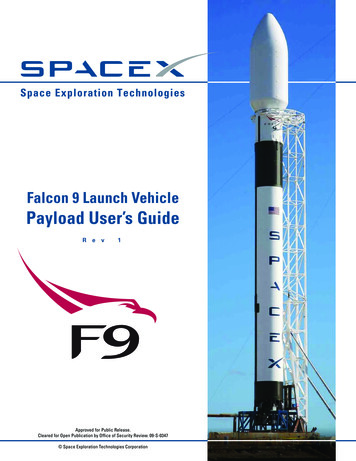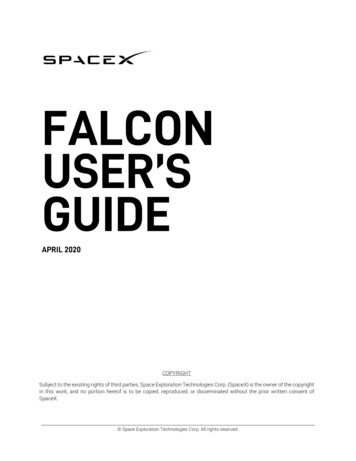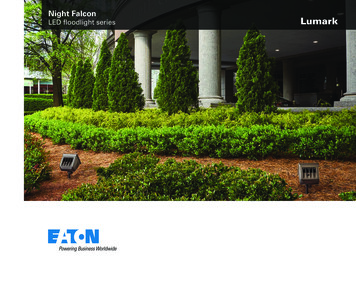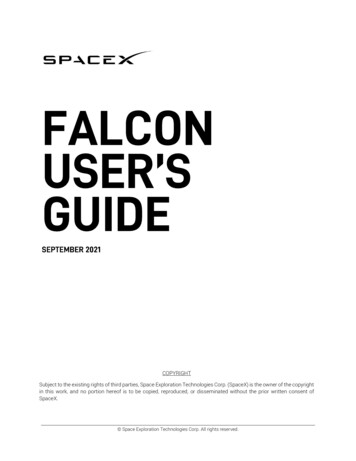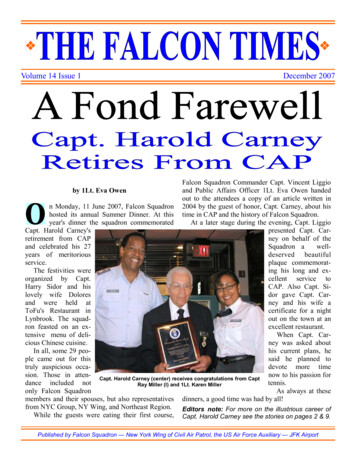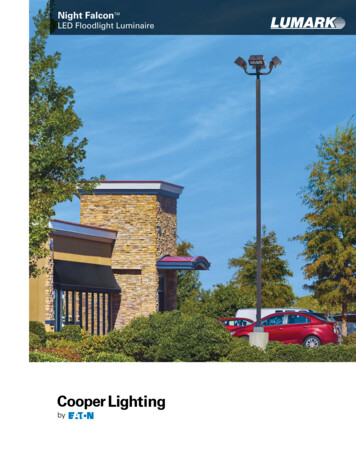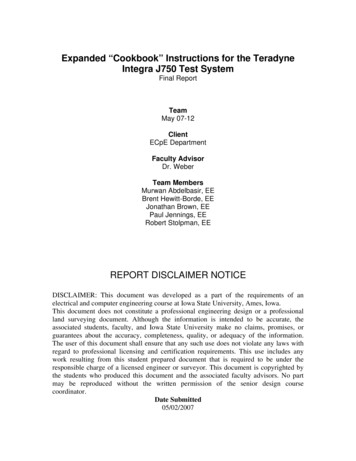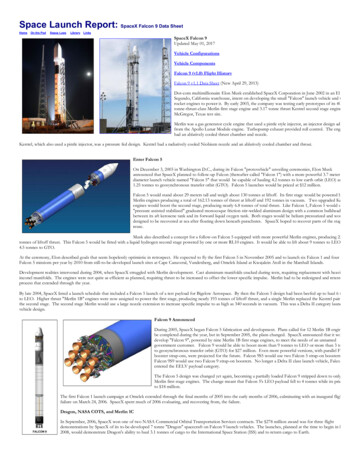
Transcription
Space Launch Report: SpaceX Falcon 9 Data SheetHomeOn the PadSpace LogsLibraryLinksSpaceX Falcon 9Updated May 01, 2017Vehicle ConfigurationsVehicle ComponentsFalcon 9 (v1.0) Flight HistoryFalcon 9 v1.1 Data Sheet (New April 29, 2013)Dot-com multimillionaire Elon Musk established SpaceX Corporation in June 2002 in an ElSegundo, California warehouse, intent on developing the small "Falcon" launch vehicle and trocket engines to power it. By early 2003, the company was testing early prototypes of its 40tonne-thrust-class Merlin first stage engine and 3.17 tonne thrust Kestrel second stage engineMcGregor, Texas test site.Merlin was a gas generator cycle engine that used a pintle style injector, an injector design adfrom the Apollo Lunar Module engine. Turbopump exhaust provided roll control. The enghad an ablatively cooled thrust chamber and nozzle.Kestrel, which also used a pintle injector, was a pressure fed design. Kestrel had a radiatively cooled Niobium nozzle and an ablatively cooled chamber and throat.Enter Falcon 5On December 3, 2003 in Washington D.C., during its Falcon "protovehicle" unveiling ceremonies, Elon Muskannounced that SpaceX planned to follow-up Falcon (thereafter called "Falcon 1") with a more powerful 3.7 meterdiameter launch vehicle named "Falcon 5" that would be capable of hauling 4.2 tonnes to low earth orbit (LEO) an1.25 tonnes to geosynchronous transfer orbit (GTO). Falcon 5 launches would be priced at 12 million.Falcon 5 would stand about 29 meters tall and weigh about 130 tonnes at liftoff. Its first stage would be powered bMerlin engines producing a total of 162.13 tonnes of thrust at liftoff and 192 tonnes in vacuum. Two upgraded Keengines would boost the second stage, producing nearly 6.8 tonnes of total thrust. Like Falcon 1, Falcon 5 would u"pressure assisted stabilized" graduated monocoque friction stir-welded aluminum design with a common bulkheadbetween its aft kerosene tank and its forward liquid oxygen tank. Both stages would be helium pressurized and woudesigned to be recovered at sea after floating down beneath parachutes. SpaceX hoped to recover parts of the stagreuse.Musk also described a concept for a follow-on Falcon 5 equipped with more powerful Merlin engines, producing 22tonnes of liftoff thrust. This Falcon 5 would be fitted with a liquid hydrogen second stage powered by one or more RL10 engines. It would be able to lift about 9 tonnes to LEO4.5 tonnes to GTO.At the ceremony, Elon described goals that seem hopelessly optimistic in retrospect. He expected to fly the first Falcon 5 in November 2005 and to launch six Falcon 1 and fourFalcon 5 missions per year by 2010 from still-to-be-developed launch sites at Cape Canaveral, Vandenberg, and Omelek Island at Kwajalein Atoll in the Marshall Islands.Development realities intervened during 2004, when SpaceX struggled with Merlin development. Cast aluminum manifolds cracked during tests, requiring replacement with heaviinconel manifolds. The engines were not quite as efficient as planned, requiring thrust to be increased to offset the lower specific impulse. Merlin had to be redesigned and retesteprocess that extended through the year.By late 2004, SpaceX listed a launch schedule that included a Falcon 5 launch of a test payload for Bigelow Aerospace. By then the Falcon 5 design had been beefed up to haul 6 tto LEO. Higher thrust "Merlin 1B" engines were now assigned to power the first stage, producing nearly 193 tonnes of liftoff thrust, and a single Merlin replaced the Kestrel pairthe second stage. The second stage Merlin would use a large nozzle extension to increase specific impulse to as high as 340 seconds in vacuum. This was a Delta II category launcvehicle design.Falcon 9 AnnouncedDuring 2005, SpaceX began Falcon 5 fabrication and development. Plans called for 12 Merlin 1B enginbe completed during the year, but in September 2005, the plans changed. SpaceX announced that it wodevelop "Falcon 9", powered by nine Merlin 1B first stage engines, to meet the needs of an unnamedgovernment customer. Falcon 9 would be able to boost more than 9 tonnes to LEO or more than 3 toto geosynchronous transfer orbit (GTO) for 27 million. Even more powerful versions, with parallel Fbooster strap-ons, were projected for the future. Falcon 9S5 would use two Falcon 5 strap-on boostersFalcon 9S9 would use two Falcon 9 strap-on boosters. No longer a Delta II class launch vehicle, Falconentered the EELV payload category.The Falcon 5 design was changed yet again, becoming a partially loaded Falcon 9 stripped down to onlyMerlin first stage engines. The change meant that Falcon 5's LEO payload fell to 4 tonnes while its pricto 18 million.The first Falcon 1 launch campaign at Omelek extended through the final months of 2005 into the early months of 2006, culminating with an inaugural flighfailure on March 24, 2006. SpaceX spent much of 2006 evaluating, and recovering from, the failure.Dragon, NASA COTS, and Merlin 1CIn September, 2006, SpaceX won one of two NASA Commercial Orbital Transportation Services contracts. The 278 million award was for three flightdemonstrations by SpaceX of its to-be-developed 7 tonne "Dragon" spacecraft on Falcon 9 launch vehicles. The launches, planned at the time to begin in l2008, would demonstrate Dragon's ability to haul 3.1 tonnes of cargo to the International Space Station (ISS) and to return cargo to Earth.
During 2006, Elon Musk also announced that SpaceX had decided to begin work on a "Merlin 1C" engine with a regeneratively cooled thrust chamber. In early February 2007, Spupdated its web site with revised design information for both Merlin and Falcon. The data was said to be effective for vehicles launched in 2009 or later. Merlin 1C was shown toproduce 46.259 tonnes of sea-level thrust - a 32% increase over the thrust produced by Merlin during the initial Falcon 1 launches. Falcon 9 was shown using nine Merlin 1C engiproviding a 20% thrust increase over the previously announced Merlin 1B engines.By the time a revised Payload User's Guide was published in May 2007, Falcon 5 had disappeared from the company's catalog altogether. Falcon 9 and Falcon 9S9 (now called FalHeavy) payloads had grown by more than 10% from earlier specifications.The second Falcon 1 failed on March 21, 2007, a victim of second stage propellant sloshing that caused loss of flight control about 5 minutes after liftoff. While the company laboto learn more lessons from its little Falcon, it forged ahead with Falcon 9 development and fabrication.Cape Canaveral Launch Site SelectionIn April 2007, SpaceX signed an agreement to lease Cape Canaveral Space Launch Complex 40, a mothballed Titan IV pad, for five years for Falcon 9 launches. The original agreincluded use of the ex-Titan IVB SMARF high bay for Falcon 9 integration, but the company subsequently decided to build a smaller horizontal integration hanger near the launchitself. The Titan IV umbilical tower was removed as a first step. On April 27, 2008, the massive Titan IV mobile service tower, once called the world's largest moving object, wasdown with demolition charges. SpaceX planned to use the Titan IV exhaust duct, lightning towers, and other structures, but Falcon 9 processing would use a "clean" pad withoutof a large mobile tower.Meanwhile, in October 2007, SpaceX moved from El Segundo to a larger (51,000 square meter) facility in Hawthorne, California. Vought Aircraft had formerly used the site tofabricate 747 fuselages for Boeing. SpaceX planned to employ 400 at the site, along with 50 in Texas and elsewhere.Falcon 9 Testing BeginsOn November 12, 2007, SpaceX announced that it had completed Merlin 1C engine development with a 170 second htest at its Texas Test Facility near McGregor, Texas. The development engine test program included 125 hot fire teststotaling more than 3,000 seconds duration. This first Merlin 1C could produce 43 tonnes of thrust at sea level and 49 tin vacuum.SpaceX shipped its first Falcon 9 first stage to McGregor in mid-2007. The stage was erected into the company's massBig Falcon Test Stand during August. During November, 2007 the first Falcon 9 hot fire test, using only one Merlin 1engine, was performed. This was followed by a two engine test in January 2008 and a three-engine test in early March,Five engine testing occurred in late May, 2008. The first nine engine test was performed on June 31, 2008, in a test thaproduced 385.5 tonnes of total thrust. Two more less-than-full-duration 9-engine tests followed.On November 23, 2008, SpaceX performed the first full-duration nine-engine Falcon 9 test at McGregor. Producing 3tonnes of total thrust while burning nearly 227 tonnes of propellant, the burn lasted 178 seconds. Two of the nine Merengines shut down as planned after 160 seconds, a sequence that mimicked the planned flight shutdown method. The late-evening test startled Central Texas residents more thanmiles away.Testing at McGregor used a battleship-type "run tank". After the full duration test, SpaceX planned to remove the "run tank" and send its engines to Cape Canaveral, where the fiFalcon 9 flight stage was expected to arrive by the end of 2008. That flight stage was expected to be used for facility testing at SLC 40, culminating in a static test firing in early 20Another flight stage was expected to arrive at McGregor for formal qualification testing. One of these stages would presumably perform the inaugural Falcon 9 launch sometime i2009.New Falcon Details EmergeIn April 2008, SpaceX revealed new details for the higher-thrust Merlin 1C that would power both Falcon 1e and a "Block 2" version of Falcon 9 that would fly in 2010 or later. Tupgraded Merlin 1C would produce 56.69 tonnes of sea-level thrust and 63.45 tonnes of thrust in vacuum, 1.5-1.6 times more than the original Merlin. With more available liftoffthrust, Falcon 1e and Falcon 9, Block 2 both grew substantially heavier and more capable.The Block 2 Falcon 9 would be able to lift nearly 10.5 tonnes to LEO from Cape Canaveral and 4.54 tonnes to a 28.5 deg GTO. Stage recovery attempts were planned when lightpayloads were launched, with unused payload mass apparently assigned to recovery hardware. Block 1 Falcon 9, powered by the initial lower-thrust Merlin 1C engines, would perfthe early COTS Demonstration flights.CRS ContractOn December 23, 2008, SpaceX won a 1.6 billion Commercial Resupply Services (CRS) contract to haul NASA cargo to the International Space Station. The contract covered 1missions planned to fly between 2010 and 2016. SpaceX would use its Dragon spacecraft to perform the missions.Cape Canaveral ValidationDuring the final days of 2008, SpaceX shipped its first Falcon 9 to Cape Canaveral SLC 40, along with the Falcon 9 laustand and launch vehicle erector. The launch vehicle, which SpaceX said included some flight components, was shipppieces on a series of trucks from Hawthorne, California. The propulsion section used for the November 23, 2008 fullduration "run tank" test in Texas was also trucked to Florida, with all nine Merlin 1C engines installed, and attached toFalcon 9 first stage. The entire vehicle, with a satellite payload fairing, was assembled near the launch pad, in the openrented cranes, by the end of the year. The launch mount and erector were also assembled. The SLC 40 Falcon 9 hangnot yet been completed. Initial efforts appeared to be focused on mechanical fit-checks.Merlin Vacuum CertificationOn March 7, 2009, SpaceX performed a full mission duration firing of the new Merlin Vacuum engine at McGregor. Tengine fired for six minutes, consumed 45.36 tonnes of propellant, and demonstrated a vacuum specific impulse of 342seconds, highest ever for a U.S. hydrocarbon rocket engine. The engine produced 41.96 tonnes of thrust in vacuumconditions.The Merlin Vacuum engine is based on the Merlin 1C, but is fitted with a larger exhaust nozzle and an added radiatively cooled expansion nozzle attachment. It has demonstratedthrottling down to 75%, with plans to test down to 60% throttling.First Flight Vehicle Acceptance TestingDuring 2009 and early 2010, the first Falcon 9 flight vehicle stages were acceptance tested at McGregor. Structural acceptance testing of both stages was completed by October 5,2009. The first stage was test fired for 10 seconds on October 12 and for 30 seconds on October 16, completing its testing program. The stage was shipped to Cape Canaveral d
November, 2009.The second stage was test fired in a second, smaller McGregor test stand for 40 seconds during November. On January 22010, the Falcon 9 second stage completed a full duration mission firing, its Merlin Vacuum engine producing 41.96 tonnthrust for 329 seconds. The stage was shipped to the Cape, where it arrived on January 29, 2010. There, it joined the firsstage in the new SpaceX SLC 40 horizontal integration hanger.Inaugural Launch CampaignSpaceX assembled its first flight Falcon 9 at Cape Canaveral SLC 40 during Februar2010. The rocket was powered up and put through an integrated systems test beforbeing rolled out to its pad on February 20. On February 26, the rocket was loaded wpropellant during its first wet dress rehersal countdown.The rocket performed a 3.5 second "hot fire" static test on March 13, 2010, during wthe nine Merlin 1C first stage engines ignited and ramped up to full thrust. The suctest took place four days after the initial attempt had been scrubbed only two seconbefore ignition. The scrubbed test identified a problem with the launch sequencer,failed to issue a command to open a ground helium valve.SpaceX Falcon 9 Inaugural Launch (Updated June 9, 2010)The first SpaceX Falcon 9 two-stage kerosene rocket launched from Cape CanaveralJune 4, 2010. Liftoff from Space Launch Complex 40 occurred at 18:45 UTC. Therocket carried a Dragon spacecraft simulator toward a planned 250 km x 34.4 deg loworbit.Falcon 9's nine Merlin first stage engines developed 387.825 tonnes of liftoff thrust toslowly lift the 320-333 tonne, 47 meter tall rocket off its launch platform. The rocketrolled slightly immediately after liftoff, but steadied itself as it cleared the pad. Falconthen flew smoothly through its initial ascent and pitch profile as it projected a thunderoar back down onto observers at the Cape and Kennedy Space Center.The center two Merlin engines shut down as planned about 165 seconds into the flight. The remaining first stage engines cut off at about 1seconds.Staging and second stage engine start - the first in-space start of a Merlin engine - appeared nominal, but a roll developed durthe five minute long burn of the second stage Merlin Vacuum engine. It was not clear if the roll had any effect on velocityperformance. The roll began about 5 minutes after liftoff, after the turbopump exhaust nozzle stopped vectoring. Merlin shdown about 517 to 524 seconds after liftoff, just as the stage completed its fourth roll. The stage was rolling about three timminute at second stage engine cutoff.SpaceX claimed that the stage and payload had reached orbital parameters very close to the planned orbit, but initial U.S. orbtracking data showed a less precise, 235 x 276 km x 34.5 deg orbit. Subsequent tracking showed the stage in a 242 x 269 kmdeg orbit.During a teleconference after the launch, Elon Musk of SpaceX stated that the second stage Merlin Vacuum engine had perfa brief "burp" restart during its first orbit as an engineering test, but provided no details of the burn. Later reports suggestedan attempted restart had failed shortly before the stage passed over Australia.Observers in eastern Australia saw the stage pass overhead about 65 minutes after liftoff. Video of the pass showed that the stage was still rolling out of control, venting gas to forspiral pattern. The observations raised questions about whether the second stage on-board cold-gas three-axis control system had either failed or if an operational system was evenflown during this test.The stage and its attached Dragon simulator were tracked until they reentered the Earth's atmosphere on June 27, 2010.Falcon 9 No. 1 produced more thrust at liftoff than any U.S.-powered kerosene-fueled rocket since Saturn IB SA-210 carried the Apollo Soyuz Test Project spacecraft with three cinto orbit on July 17, 1975. Merlin Vacuum performed the first U.S. turbopump-fed kerosene engine air-start since the last Titan I ICBM flew in 1965.Falcon 9 Orbits Dragon C1The second SpaceX Falcon 9 successfully boosted the company's Dragon C1 spacecraft into orbit from Cape Canaveral on December 8, 2010. The two-stage, 313 tonne,kerosene/LOX rocket thundered aloft off from Space Launch Complex 40 at 15:43 UTC. After a nearly nine-minute propulsion phase and a 20 second coast, Dragon C1 separatfrom Falcon 9's second stage, leaving its aft "trunk" section attached to the stage on this test flight, into a reported 288 x 301 km x 34.53 deg orbit, beginning a test flight planned
least two orbits.Dragon subsequently completed two orbits, demonstrating active flight control through use of its 18 Dthrusters. According to some reports, one Draco failed to function, but redundancy in the flight contrsystem design allowed the flight to continue. Elon Musk himself said after the flight that all thrustersworked. After two orbits, Dragon fired four Dracos beginning at about 18:17 UTC to initiate reentry.capsule reentered over the Pacific Ocean and splashed down at about 19:02 UTC beneath three parachabout 800 km off the northwest coast of Mexico.Dragon C1 was the first SpaceX flight for NASA's Commercial Orbital Transportation Services (COTcontract. It was the first spacecraft successfully launched and recovered from orbit by a commercialcompany. Only countries - the United States, Russia, China, Japan, India, and the European Space Aghave previously performed the feat.After Dragon deployed, several "CubeSat" microsatellites were released into low Earth orbit, likely fromDragon trunk section that remained attached to the top of the orbiting Falcon 9 second stage on this tmission. One flew for the Naval Research Laboratory. Another, the first U.S. Army built satellite in mthan 50 years, was identified as the Space and Missile Defense Command - Operational Nanosatellite Eor SMDC-ONE.After the flight, CEO and Chief Engineer Elon Musk announced that the second stage Merlin Vacuum engine had successfully restarted in a test, propelling the stage to a 288 x 11km x 34.6 deg elliptical orbit. The first stage was not recovered, but telemetry of the stage reentry was recovered through use of a data pod.Merlin 1D, Falcon Heavy, and the future of Falcon 9Falcon Heavy as Originally Presented by SpaceX, April 2011On April 5, 2011, SpaceX announced that it would develop a triple-body Falcon Heavy powered by an upgraded ennamed Merlin 1D. Each of the rocket's 27 Merlin 1D engines would produce 63.5 tonnes thrust at sea level, nearltimes more than the Merlin 1C engines that powered the first two Falcon 9 rockets. Using the new engines, combiwith propellant crossfeeding from the twin boosters to the central core, Falcon Heavy would be able to lift a surpri53 tonnes to LEO, 19 tonnes to GTO, or 13.6 tonnes toward Mars. Plans called for the first Falcon Heavy to fly ademonstration mission in 2013 from Vandenberg AFB Space Launch Complex 4 East, the former Titan 4 pad.SpaceX also divulged plans for a two-stage Falcon 9 powered by nine Merlin 1D engines. This Falcon 9, substantiamore capable than either Falcon 9 Block 1 or Block 2, would be able to lift 16 tonnes to LEO or 5 tonnes to GTOwould stand 69.2 meters, and would weigh 480 tonnes at liftoff. The company continued to show Falcon 9 Blockthe baseline in its Payload Users Guide.On April 25, 2011, Elon Musk, in a Space News interview, confirmed that Falcon Heavy would use a "stretched" F9 stage augmented by two additional "first stages". He stated that Merlin 1D would fly in mid-2012 on a Falcon 9mission, most likely on the seventh flight of the rocket. Mr. Musk described how the Merlin 1D combustion chambeing explosively formed, streamlining the production process. He noted that a fully integrated Merlin 1D was alrebeing test-fired.seconds.During the August 2011 Joint Propulsion Conference, SpaceX VP of Propulsion Tom Mueller said that the Merlintest engine had demonstrated a thrust to weight ratio greater than 160:1 and a vacuum specific impulse greater thanDesign details of Falcon Heavy, and of Merlin 1D performance, have not been divulged. In order to achieve the payload capability claimed by SpaceX, the new rocket engine willto provide improved specific impulse and the stages will have to provide very high propellant mass ratios. SpaceX claimed that the two "first stage" strap-on units will achieve a 30gross mass to dry mass ratio, implying an unprecedented propellant mass fraction of better than 0.966.Falcon 9 Block 1 and Falcon 9 v1.1 ComparisonOn May 14, 2012, NASA announced that it had modified its Launch Services (NLS) II contract withSpace Exploration Technologies (SpaceX) by adding a new "Falcon 9 v1.1" variant to the program.modification allowed SpaceX to offer "Falcon 9 v1.1" in competition for future launch contracts.An image of "Falcon 9 v1.1" was provided during a presentation made on March 9, 2012 by JeffreyWhite, an Iridium Director. The image showed a stretched Falcon 9, with both stages stretched. Itshowed, compared to Falcon 9 Block 1, shortened interstage and propulsion sections. The bigger rappeared to be outfitted with Merlin 1D engines, possibly in a rearranged configuration.By appearances, "Falcon 9 v1.1" represents an improvement over the long-expected "Falcon 9 Blocthat, originally, was to be powered by improved Merlin 1C engines. The SpaceX user's guide continshow outmoded "Block 2" performance data as of May 14, 2012, but the SpaceX web site was updated with v1.1 performance number on June 6 or 7, 2011.The Merlin 1D powered "Falcon 9 v1.1" is likely the building block for the company's announced Falcon Heavy, but "v1.1" should also be a substantial performer in its own rightpushing deep into EELV payload territory. Falcon 9 v1.1 will likely premier at Vandenberg AFB Space Launch Complex 4 East during 2013. During a May 18, 2012 interview, EMusk said that all Falcon 9 rockets after the first five would be 1.1 versions. He also referred to the original Falcon 9 as "v1.0". An extension of the Cape Canaveral SLC 40 Hangwas underway during May, 2012 to accomodate the longer rocket.Falcon 9 Orbits Dragon on COTS C2 MissionMerlin 1C Engines Undergoing Chilldown During Final Minutes of CountdownThe third SpaceX Falcon 9 rocket successfully orbited the company's first fully functional Dragon spacecraft on the COTS C2 Demonstration Mission for NASA on May 22, 20The two stage, kerosene fueled rocket lifted off from Cape Canaveral Space Launch Complex 40 at 07:44 UTC, beginning an ambitious mission that, if fully implemented, would sspacecraft docked to the International Space Station for two weeks.It was Falcon 9's first night launch. The liftoff ended a 17 month hiatus for the launch vehicle as SpaceX worked to prepare Dragon for the C2 mission.
gpp pgFalcon 9 No. 3 LiftoffFalcon 9's first stage burned for three minutes, its second stage for an additional 6 minuteseconds, to inject Dragon into a 297 x 346 km x 51.6 deg phasing orbit. Dragon's twin soarrays, on their inaugural flight, deployed shortly after spacecraft separation. The arrays wattached to Dragon's "trunk", an aft module attached to the cone shape spacecraft that waon its first fully configured flight.The launch occurred three days after a last second launch abort that was caused by a faulthelium purge check valve on the launcher's center Merlin 1C engine. Crews identified theproblem and replaced the valve while Falcon 9 remained vertical on the pad.Dragon C2 Integration with TrunkSLC 40 Hanger (Left) and ApproachISS (Right)Dragon carried 460 kg of demonstration cargo for ISS. Plans call for it to return 620 kg of cargo when it reenters and splashes down in the Pacific Ocean. But the ISS docking iscontingent on Dragon successfully completing a series of demonstration maneuvers for NASA during the first two days of its mission, before it will be allowed to approach ISS focapture berthing.Dragon Arrives at ISSISS crew successfully captured the SpaceX Dragon C2 spacecraft on May 25, 2012, after a slight delay due to a LIDAR issue. The 5-7 tonne spacecraft (SpaceX has not revealedmass) was susequently berthed to the station.
It is the first visit by a commercial spacecraft to the International Space Station.At this point in the flight, Dragon had begun to demonstrate objectives originally intended for astandalone "C3" mission.Dragon ReturnsSpaceX's Dragon C2 successfully ended its mission on May 31, 2012 when the capsule spacecrasplashed down beneath three parachutes in the Pacific Ocean off the coast of Baja California at 1UTC. Dragon had departed the International Space Station about 7.5 hours earlier, at 08:07 UTCThe cargo spacecraft carried more than 600 kg of "down" cargo, including experiments and oldequipment. The reentry and splashdown ended Dragon's COTS 2 demonstration mission for Nopening the way for more cargo flights.Falcon 9 Orbits Dragon CRS-1 with ISS Cargo, Suffers Engine Shutdown During AscentLeaves Secondary Payload in Low Orbit (Updated 10/12/12)SpaceX launched its fourth Falcon 9 rocket on October 8, 2012, this time carrying the firstoperational Dragon spacecraft on NASA's CRS-1 resupply mission to the International SpaceStation. Liftoff from Cape Canaveral SLC 40 occurred at 00:35 UTC. The second stage insertDragon into a 197 x 328 km x 51.65 deg orbit about 9 minutes 49 seconds later. Dragon CRSseperated and deployed its solar arrays.During the ascent, a flare was observed in the first stage plume about 79 seconds after liftoff,approximately coinciding with the period of maximum dynamic pressure on the vehicle (or "MQ"). The first stage burned about 12-13 seconds longer than expected, and the second stage bu15-16 seconds longer than planned. SpaceX subsequently stated that an "anomaly" had occurreone of the rocket's nine first stage Merlin 1C engines, causing it to shut down. The on boardguidance system compensated for the loss of thrust by commanding longer burns and a modifieflight profile.The spacecraft, filled with 400 kg of supplies, was expected to reach the space station on October 10.Falcon's second stage was expected to perform a second burn after Dragon separation, to insert a 165 kg Orbcomm prototype satellite into a 350 x 750 km orbit. Short ofsufficient propellant, and unable to perform any burn with the remaining propellant due to ISS safety constraints, Falcon deployed Orbcomm into a 203 x 323 km x 51.65 deorbit from which it fell into a destructive reentry into the earth's atmosphere on Ocbober 10, a total loss for Orbcomm.Despite the successful Dragon insertion, the improper Orbcomm orbit result requires Space Launch Report, given its uncompromising success/fail methodology, to now clasthe launch as a failure.It was the second Falcon 9/Dragon launch of 2012.
SpaceX Dragon Arrives at Station (Updated 10/12/12)SpaceX successfully delivered Dragon C3 (CRS-1), NASA's first operational commercial cargo mission, to the InternatSpace Station on October 10, 2012. ISS Expedition 33 crew members Akihiko Hoshide and Sunita Williams used thestation's robotic arm to grapple and berth Dragon to the station's Harmony module at 11:56 UTC and 1303 UTC,respectively.Dragon is expected to stay at ISS for 18 days while 400 kg of cargo is unloaded and 759 kg of downmass, including usestation hardware and scientific samples, is loaded. Dragon will carry the down cargo to a planned October 28 parachulanding on the Pacific Ocean off the coast of southern California.SpaceX CRS-1 is the first of 12 Commercial Resupply Services missions contracted for NASA. The program has a 1.billion budget.The Dragon CRS-1 success came despite the challenging failure of one of its nine Falcon 9 first stage engines 79 seconafter liftoff. The lost engine caused Falcon 9's first and second stages to burn longer, forcing the second stage to consslightly more propellant than planned to boost Dragon into its planned insertion orbit. The first stage burned 12-13 selonger, and the second stage 15-16 seconds longer, than the planned 180 seconds and 359 seconds, respectively.The Falcon 9 second stage was slated to perform a second burn after Dragon separation to insert a 165 kg Orbcomm prototype satellite into a 350 x 750 km orbit. Although the sstage retained enough propellant to very likely achieve the planned orbit, NASA had required prior to the mission that any second stage restart could only occur if there was a bettthan 99% probability of completing the burn. This was to ensure that the stage and its payload were safely lifted above the ISS orbit. After the extended first burn, the second staonly retained enough propellant to achieve a roughly 95% probability of completing the second burn, so Falcon 9 did not attempt a restart. Orbcomm had to be released into the203 x 323 km x 51.65 deg orbit, from which it soon, on October 10, fell back to a destructive reentery into the earth's atmosphere.The last time a U.S. rocket lost a first stage engine during ascent but still made it to orbit was the SA-6 flight of May 28, 1964. SA-6 survived an unexpected S-1 outboard engine (shutdown 116 seconds after liftoff. The remaining H-1 engines burned about two seconds longer to compensate, with the inboards shutting down at T 142 seconds and the outbat T 148 seconds. The S-IV stage compensated for the early shutdown to enter a 124 x 140 mile x 31.5 degree orbit, close to the planned 110 x 140 mile orbit. Subsequent Saturnand Space Shuttle launches also overcame early engine shutdowns to reach orbit, but in those cases the engines were second stage
Dragon, NASA COTS, and Merlin 1C In September, 2006, SpaceX won one of two NASA Commercial Orbital Transportation Services contracts. The 278 million award was for three flight demonstrations by SpaceX of its to-be-developed 7 tonne "Dragon" spacecraft on Falcon 9 launch vehicles. The launches, planned at the time to begin in l
